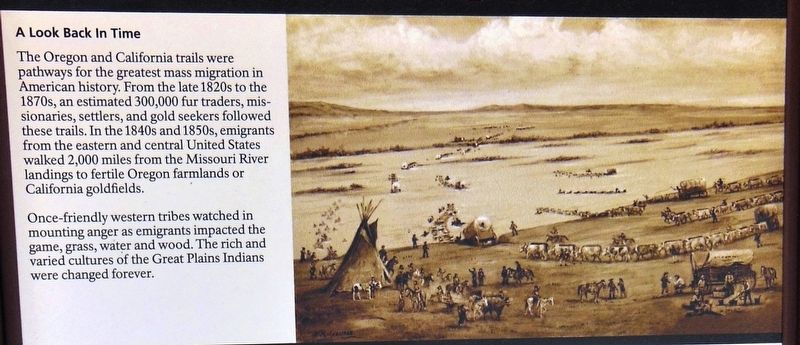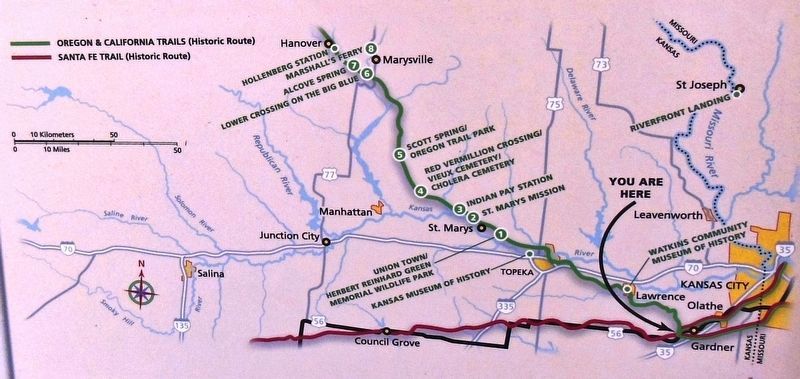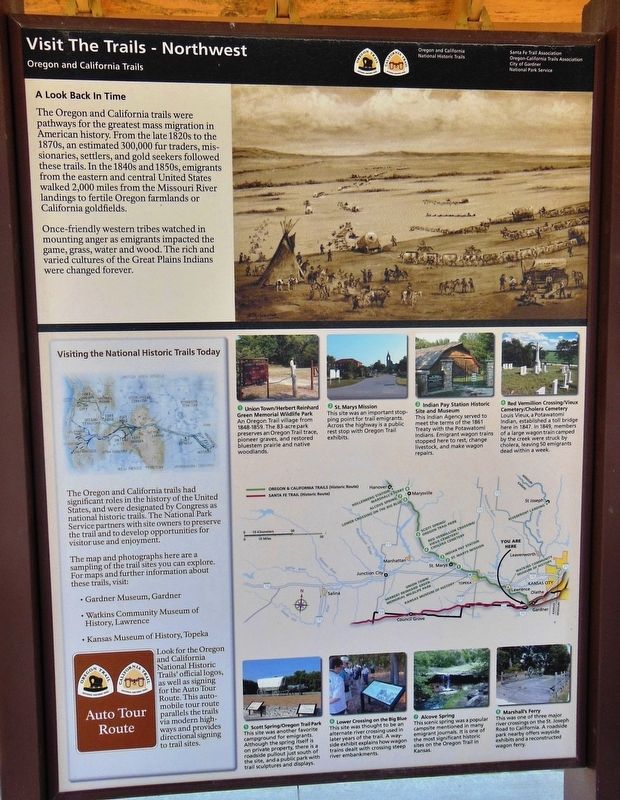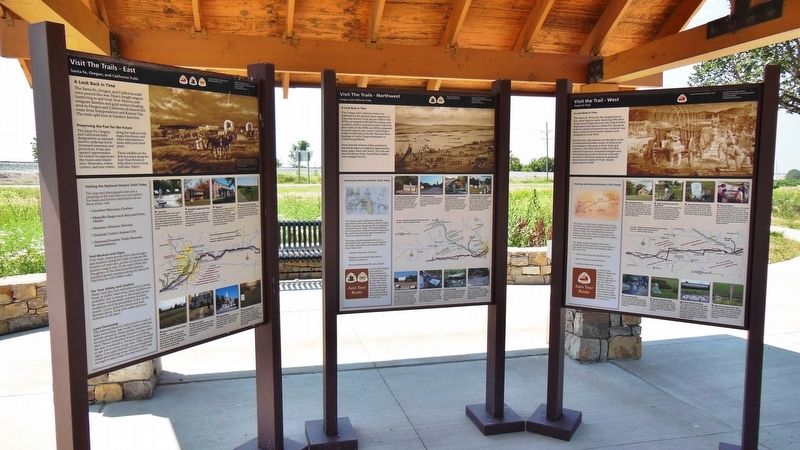Gardner in Johnson County, Kansas — The American Midwest (Upper Plains)
A Look Back in Time
The Oregon and California trails were pathways for the greatest mass migration in American history
Once-friendly western tribes watched in mounting anger as emigrants impacted the game, grass, water and wood. The rich and varied cultures of the Great Plains Indians were changed forever.
Visiting the National Historic Trails Today
The Oregon and California trails had significant roles in the history of the United States, and were designated by Congress as national historic trails. The National Park Service partners with site owners to preserve the trail and to develop opportunities for visitor use and enjoyment.
The map and photographs here are a sampling of the trail sites you can explore. For maps and further information about these trails, visit:
• Gardner Museum, Gardner
• Watkins Community Museum of History, Lawrence
• Kansas Museum of History, Topeka
Look for the Oregon and California National Historic Trails' official logos, as well as signing for the Auto Tour Route. This automobile tour route parallels the trails via modern highways and provides directional signing to trail sites.
1. Union Town/Herbert Reinhard Green Memorial Wildlife Park
An Oregon Trail village from 1848-1859. The 83-acre park preserves an Oregon Trail trace, pioneer graves, and restored bluestem prairie and native woodlands.
2. St. Marys Mission
This site was an important stopping point for trail emigrants. Across the highway is a public rest stop with Oregon Trail exhibits.
3. Indian Pay Station Historic Site and Museum
This Indian Agency served to meet the terms of the 1861 Treaty with the Potawatomi Indians. Emigrant wagon trains stopped here to rest, change livestock, and make wagon repairs.
4. Red Vermillion Crossing/Vieux Cemetery/Cholera Cemetery
Louis Vieux, a Potawatomi Indian, established a toll bridge here in 1847. In 1849, members of a large wagon train camped by the creek were struck by cholera, leaving 50 emigrants dead within a week.
5. Scott Spring/Oregon Trail Park
This site was another favorite campground for emigrants. Although the spring itself is on private property, there is a roadside pullout just south of the site, and a public park with trail sculptures and displays.
6. Lower Crossing on the Big Blue
This site was thought to be an alternate river crossing used in later years of the trail. A wayside exhibit explains how wagon trains dealt with crossing steep river embankments.
7. Alcove Spring
This scenic spring was a popular campsite mentioned in many emigrant journals. It is one of the most significant historic sites on the Oregon Trail in Kansas.
8. Marshall's Ferry
This was one of three major river crossings on the St. Joseph Road to California. A roadside park nearby offers wayside exhibits and a reconstructed wagon ferry.
Erected by Santa Fe, Oregon and California National Historic Trails, City of Gardner and National Park Service.
Topics and series. This historical marker is listed in these topic lists: Native Americans • Roads & Vehicles • Settlements & Settlers. In addition, it is included in the California Trail, and the Oregon Trail series lists. A significant historical year for this entry is 1861.
Location. 38° 47.786′ N, 94° 57.702′ W. Marker is in Gardner, Kansas, in Johnson County. Marker can be reached from the intersection of U.S. 56 and West 183rd Street, on the right when traveling west. This marker is the center panel of a three-panel marker kiosk near the parking lot at Gardner Junction Park. Touch for map. Marker is at or near this postal address: 32505 West 183rd Street, Gardner KS 66030, United States of America. Touch for directions.
Other nearby markers. At least 8 other markers are within 2 miles of this marker, measured as the crow flies. A different marker also named A Look Back in Time (here, next to this marker); a different marker also named A Look Back in Time (here, next to this marker); Eye of the Needle (within shouting distance of this marker); Following Their Dreams (within shouting distance of this marker); Apprehension and Conflict (within shouting distance of this marker); From Prairie Schooners to Locomotives (within shouting distance of this marker); Overland Trails (approx. 1.9 miles away); The Herman B. Foster Home (approx. 1.9 miles away). Touch for a list and map of all markers in Gardner.
Related markers. Click here for a list of markers that are related to this marker. Gardner Junction: Santa Fe, Oregon, and California Trails
Also see . . .
1. Oregon National Historic Trail. Robert Stuart of the Astorians (a group of fur traders who established Fort Astoria on the Columbia River in western Oregon) became the first white man to use what later became known as the Oregon Trail. Stuart's 2,000-mile journey from Fort Astoria to St. Louis in 1810 took 10 months to complete. It wasn't until 1836 that the first wagons were used on the
trek from Missouri to Oregon. A missionary party headed by Marcus and Narcissa Whitman bravely set out to reach the Willamette Valley. Though the Whitmans were forced to abandon their wagons 200 miles short of Oregon, they proved that families could go west by wheeled travel. (Submitted on March 24, 2019, by Cosmos Mariner of Cape Canaveral, Florida.)
2. California Trail. Follow in the footsteps of over 250,000 emigrants who traveled to the gold fields and rich farmlands of California during the 1840s and 1850s: the greatest mass migration in American history. The California National Historic Trail is over 5,000 miles long and covers portions of 10 states. Step into history along more than 1,000 miles of ruts and traces from travelers and their overland wagons. (Submitted on March 24, 2019, by Cosmos Mariner of Cape Canaveral, Florida.)
Credits. This page was last revised on March 24, 2019. It was originally submitted on March 24, 2019, by Cosmos Mariner of Cape Canaveral, Florida. This page has been viewed 371 times since then and 23 times this year. Photos: 1, 2, 3, 4. submitted on March 24, 2019, by Cosmos Mariner of Cape Canaveral, Florida.



